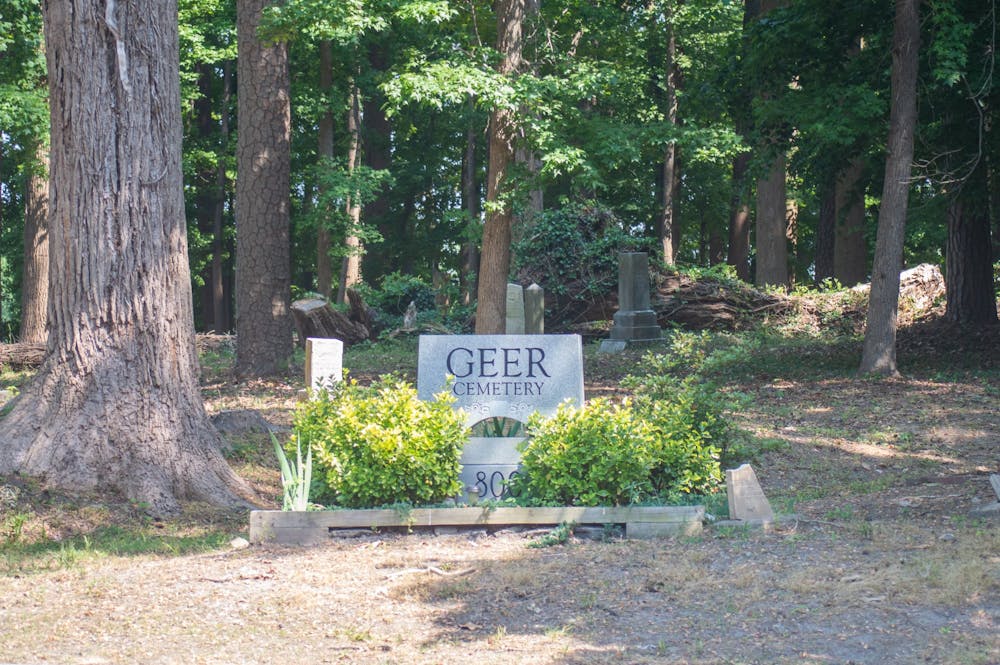Stewart said the organization originally hosted community clean-ups until the city took on more responsibility for regular maintenance. Now, he said, they focus on researching the individuals who are buried there and reaching out to their descendants.
Adam Rosenblatt, a Friends of Geer Cemetery board member and professor at Duke University, taught a service-learning course titled “Death, Burial and Justice in the Americas.” His students worked with the Friends of Geer Cemetery to reconstruct narratives of individuals buried there.
Their work started with a large shared document, Andrew Witte, a student in Rosenblatt's course, said. The document included a list of everyone who Friends of Geer Cemetery believes is buried in the cemetery, based on city records. All of the students were encouraged to choose names at random, he said.
“I think one of the most amazing things for me was just the fact that you could get this name, and you could reconstruct their narrative,” Witte said.
Witte started with genealogical research, using ancestry libraries available through Duke. He was then encouraged to leverage public records to find more details of an individual’s story. The organization taught students to conduct supplementary research, using newspaper clippings, news archives and property records, among other sources, to piece together the details of the lives of the deceased.
But for many individuals, the research was spotty. Molly Mendoza, another student in Rosenblatt's course, said that little information was available regarding the lives of children. All of the documentation is handwritten, meaning some documentation is unreadable or incorrectly spelled, making it difficult to match up multiple sources, she said.
Witte also found that some sources may be steeped in racism and misogyny. Acknowledging that bias when building the narrative helped challenge that language and bring justice to the individuals they researched, he said.
Expanding Geer Cemetery’s reach
Deidre Barnes, a Friends of Geer Cemetery board member, has ancestors buried there and is a distant descendant of Jesse Geer, the original owner of the land that eventually became the cemetery. Her involvement started as a way to explore her family’s history — Geer is her grandmother’s maiden name.
Barnes said people might not even know about the existence of Black cemeteries. Her grandfather had relatives buried in Violet Park Cemetery, located on Moline Street, until the city approved construction of a parking lot over the cemetery, she said. Families were left with the costs of excavating, transporting and burying their loved ones again, she said, and her grandfather could not afford those costs. As a result, his father and his two sisters are still in Violet Park Cemetery — now under a parking lot.
Part of the Friends of Geer Cemetery’s work is what Gonzalez-Garcia refers to as “descendant outreach” — the organization reaches out to descendants who might not know about their family’s connection to the cemetery.
Earlier this year, the organization debuted the “In Plain Sight” exhibit, which included educational panels along the cemetery’s carriage track that was paired with virtual programming. Gonzalez-Garcia said this exhibit drew in more visitors than the organization has ever seen — in total, over 200 people participated in guided tours, with additional private tours as well.
To get the day's news and headlines in your inbox each morning, sign up for our email newsletters.
The popularity of the exhibit increased awareness of Friends of Geer Cemetery, helping the organization connect with descendants who may have lost touch with their family’s ancestry in the cemetery, Gonzalez-Garcia said.
“My mission is that this is a perpetual organization,” Gonzalez-Garcia said. “It’s something to always be a watchdog for the cemetery and to make sure that it has its place in our history and the dignity it deserves.”
The need for perpetual care
Community-led care has brought in Durham residents to research and restore Geer Cemetery, but it's not a perfect approach. The Friends of Geer Cemetery relies on volunteers to drive this effort, and there is no perpetual care fund the organization can draw on, Levy said.
In addition to volunteer time, Gonzalez-Garcia said, the organization is actively working to increase member engagement and encourage membership renewal. Membership fees are $5, and Friends of Geer Cemetery has found that community members are reaching out to the organization to join, she said.
Rosenblatt said he does not think Geer Cemetery necessarily needs the manicured appearance of cemeteries that rely on perpetual care funds. Rather, he said, caring for the cemetery requires continued community involvement and meaningful partnership with the descendants of individuals who are buried there.
“Part of me says this is the only thing that’s sustainable, because it depends on the community,” Rosenblatt said. “And if the community loses interest, you can have a very well-maintained cemetery, but it’s not a place of meaning.”
@nihavattikonda
@DTHCityState | city@dailytarheel.com




